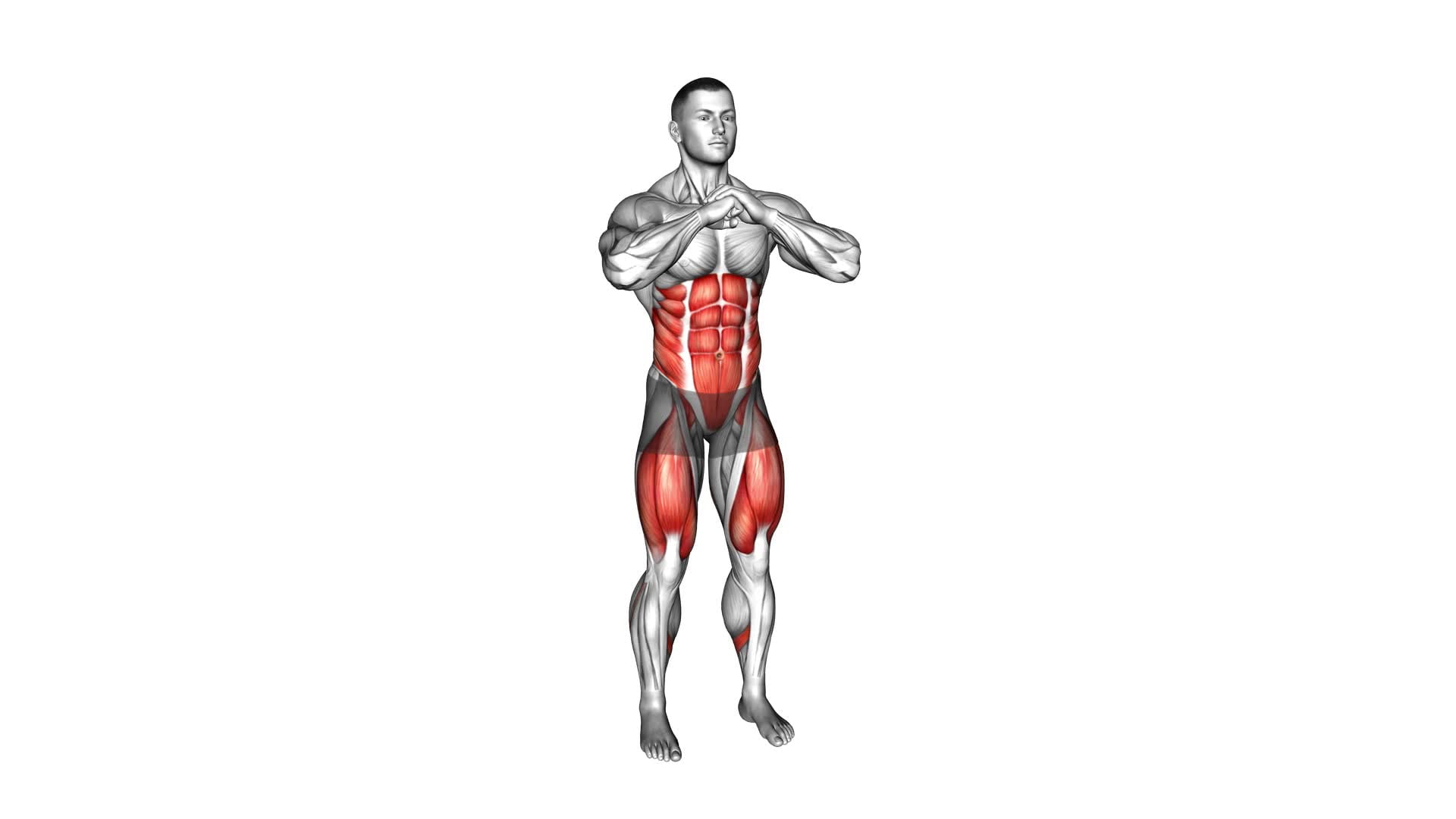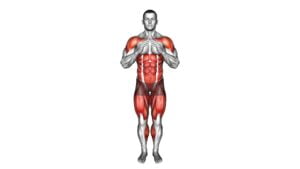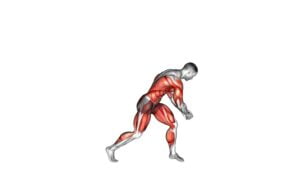Standing Turn and Knee Raise (male) – Video Exercise Guide & Tips

Are you looking for a challenging and effective exercise to incorporate into your workout routine? Look no further than the Standing Turn and Knee Raise.
Watch This Exercise Video
In this video exercise guide, we'll walk you through step-by-step instructions on how to perform this move correctly. Whether you're a beginner or an advanced athlete, we'll also provide modifications and variations to suit your fitness level.
Get ready to strengthen your core and improve your balance with this dynamic exercise. Let's dive in!
Key Takeaways
- Standing Turn and Knee Raise targets core muscles including abdominals, obliques, and lower back.
- It strengthens the core for stability and better posture.
- This exercise improves balance and coordination.
- When performing Standing Turn and Knee Raise, it is important to rotate the torso from the waist, not the hips, for effective core engagement.
Benefits of the Standing Turn and Knee Raise
Increase your core strength and improve your balance with the Standing Turn and Knee Raise exercise. This exercise offers numerous benefits when performed with proper form.
One of the main benefits is that it targets your core muscles, including your abdominals, obliques, and lower back. By engaging these muscles, you can strengthen your core, which is essential for overall stability and posture.
Additionally, the Standing Turn and Knee Raise exercise helps to improve your balance. As you rotate your torso and raise your knee, you challenge your body's ability to maintain equilibrium. Over time, this can lead to better balance and coordination in your daily activities.
To maximize the benefits of this exercise, it's crucial to maintain proper form. Start by standing tall with your feet hip-width apart. Engage your core and keep your shoulders relaxed. As you rotate your torso, make sure to turn from your waist and not your hips. This will help to target your core muscles effectively. When raising your knee, aim to bring it up towards your chest while maintaining a stable and upright posture.
Incorporating the Standing Turn and Knee Raise exercise into your fitness routine can bring about significant improvements in your core strength and balance.
Now, let's discuss the equipment needed for this exercise.
Equipment Needed for the Exercise
To perform the Standing Turn and Knee Raise exercise, you'll need a stability ball or a chair. These pieces of equipment provide stability and support during the exercise, allowing you to focus on proper form and technique.
In addition to the Standing Turn and Knee Raise, there are other exercises that can be performed using the same equipment. For example, you can use the stability ball or chair for exercises like seated leg raises, seated knee extensions, or even seated twists to engage different muscle groups in your lower body and core.
Before attempting the Standing Turn and Knee Raise, it's important to properly warm up your body. This helps to prepare your muscles and joints for the exercise, reducing the risk of injury. Some effective warm up exercises to consider include marching in place, leg swings, or even light cardio exercises like jogging or jumping jacks. These dynamic movements increase blood flow to your muscles, improve flexibility, and help you perform the Standing Turn and Knee Raise more effectively.
Now that you know the equipment needed and the importance of warming up, let's move on to the step-by-step guide to performing the Standing Turn and Knee Raise.
Step-By-Step Guide to Performing the Standing Turn and Knee Raise
To perform the Standing Turn and Knee Raise exercise, begin by standing with your feet shoulder-width apart. This exercise is great for targeting your core muscles and improving your balance.
Here is a step-by-step guide to help you perform it with proper technique and maximize muscle activation:
- Start by shifting your weight onto your right leg while keeping your left foot slightly off the ground.
- Engage your core muscles and slowly raise your left knee towards your chest while simultaneously turning your upper body to the left.
- Hold this position for a few seconds, focusing on maintaining your balance.
- Lower your left leg back down to the starting position and repeat the movement on the opposite side.
Remember to keep your movements controlled and avoid using momentum to lift your knee. This will ensure that your core muscles are properly engaged throughout the exercise.
You can perform multiple sets of 10 to 12 repetitions on each leg to achieve maximum benefits. As you become more comfortable with the exercise, you can increase the intensity by holding a dumbbell or medicine ball in your hands while performing the movement.
Common Mistakes to Avoid During the Exercise
To ensure proper form during the Standing Turn and Knee Raise exercise, keep your back straight, shoulders relaxed, and core engaged.
Avoid using excessive momentum to swing your leg up, as this can lead to loss of balance and strain on the lower back.
Remember to breathe deeply and exhale as you raise your knee to maintain stability and control throughout the movement.
Proper Form Tips
Avoid these 3 common mistakes to maintain proper form during the Standing Turn and Knee Raise exercise.
- Not engaging your core: To avoid injury and maximize effectiveness, it's crucial to engage your core muscles throughout the exercise. This will help stabilize your body and prevent excessive strain on your lower back.
- Swinging your leg: To maintain proper form, avoid swinging your leg during the knee raise. Instead, focus on controlled movements, lifting your knee towards your chest and maintaining a slow and controlled pace.
- Arching your back: Keep your back straight and avoid arching it during the exercise. Arching your back can cause unnecessary strain on your spine and lead to discomfort or injury.
- Using momentum: It's important to rely on your muscles, rather than momentum, to perform the exercise. Avoid using excessive swinging or momentum to lift your leg. Instead, focus on controlled movements and engaging the targeted muscles.
Avoiding Excessive Momentum
Engage your core, lift your knee towards your chest, and maintain a slow and controlled pace to avoid excessive momentum during the Standing Turn and Knee Raise exercise.
Excessive momentum can compromise the effectiveness of the exercise and increase the risk of injury.
Before performing this exercise, it's important to properly warm up your body to increase blood flow and prepare your muscles for the movement. A proper warm-up can include light cardio exercises and dynamic stretches.
Additionally, focus on muscle activation by contracting your core and engaging the muscles in your legs and hips. This will help stabilize your body and prevent any swinging or jerking motions that can lead to excessive momentum.
Breathing Techniques for Stability
Maintain stability and control during the Standing Turn and Knee Raise exercise by practicing proper breathing techniques. Proper breathing can help enhance your core stability and ensure that you're able to perform the exercise with control and precision.
Here are some common mistakes to avoid and tips for effective breathing:
- Breathe in through your nose and out through your mouth to maximize oxygen intake and release carbon dioxide.
- Exhale as you turn your torso and lift your knee, engaging your core muscles.
- Avoid holding your breath or taking shallow breaths, as this can limit your stability and energy output.
- Coordinate your breath with your movements, inhaling during the initial movement and exhaling during the exertion phase.
Modifications and Variations for Different Fitness Levels
To adapt the standing turn and knee raise exercise for different fitness levels, you can incorporate modifications and variations.
For beginners, it's important to start with modifications that make the exercise more manageable. One modification is to reduce the range of motion by not raising the knee as high. Instead of lifting the knee to a 90-degree angle, beginners can start by lifting the knee to a comfortable height.
Another modification is to use a support, such as a chair or wall, to assist with balance. This can help beginners maintain stability while performing the exercise.
For those at an advanced fitness level, there are variations that can make the standing turn and knee raise exercise more challenging. One advanced variation is to add weights. Holding dumbbells or kettlebells while performing the exercise increases the resistance and engages the muscles even more.
Another advanced variation is to incorporate a twist with the upper body. As you lift your knee, rotate your torso in the opposite direction. This adds an element of core stability and enhances the overall effectiveness of the exercise.
Tips for Incorporating the Standing Turn and Knee Raise Into Your Workout Routine
To incorporate the standing turn and knee raise exercise into your workout routine, consider these helpful tips:
- Start with a proper warm-up: Before performing any exercise, it's important to warm up your muscles to prevent injury. Incorporate some dynamic stretches and light cardio exercises into your routine to get your body ready for the workout.
- Focus on balance: The standing turn and knee raise exercise is great for improving balance. To make the most of this exercise, engage your core and focus on maintaining your balance throughout the movement. This won't only target your abs but also strengthen your stabilizer muscles.
- Gradually increase difficulty: As you become more comfortable with the standing turn and knee raise, you can increase the difficulty level by adding weights or using a stability ball. These variations will challenge your balance even more and provide a greater workout for your muscles.
- Explore alternative knee raise variations: While the standing turn and knee raise is an effective exercise, it's always good to switch things up. Try incorporating other knee raise variations such as side knee raises or reverse knee raises to target different muscle groups and keep your workout routine interesting.
By incorporating balance exercises like the standing turn and knee raise into your workout routine and exploring alternative knee raise variations, you can improve your balance, strengthen your core, and add variety to your workouts. Remember to listen to your body and adjust the intensity as needed.
Happy exercising!
Frequently Asked Questions
How Many Calories Does the Standing Turn and Knee Raise Exercise Burn?
The standing turn and knee raise exercise is a great way to burn calories and work your core and lower body. By rotating your torso and lifting your knee, you engage multiple muscles, increasing your heart rate and calorie burn. This exercise also helps improve balance and coordination.
To get the most out of this exercise, make sure to maintain proper form and avoid common mistakes like using momentum or arching your back. There are also variations and modifications you can try to challenge yourself or accommodate any physical limitations.
Can the Standing Turn and Knee Raise Exercise Help Improve Balance?
The standing turn and knee raise exercise is a great way to improve balance. By incorporating variations of this exercise into your routine, you can challenge your stability and strengthen your core muscles.
Balance training has numerous benefits, including reducing the risk of falls and enhancing athletic performance. Adding this exercise to your workout regimen can help you develop better coordination and stability, leading to improved balance in your daily activities.
Is It Necessary to Warm up Before Performing the Standing Turn and Knee Raise Exercise?
Before performing the standing turn and knee raise exercise, it's necessary to warm up. Warming up helps prepare your muscles and joints for the exercise, reducing the risk of injury. Additionally, warming up increases blood flow, which can enhance the benefits of the standing turn and knee raise exercise.
There are variations of this exercise that can challenge different muscle groups and increase the intensity. Remember to listen to your body and start with a warm-up to get the most out of this exercise.
Can the Standing Turn and Knee Raise Exercise Be Done by Individuals With Knee Injuries?
Yes, the standing turn and knee raise exercise can be modified for individuals with knee injuries.
If you have a knee injury, it's important to consult with a healthcare professional or physical therapist for rehabilitation options.
They can provide you with specific modifications and exercises that are safe and effective for your condition.
Are There Any Specific Breathing Techniques to Follow While Performing the Standing Turn and Knee Raise Exercise?
When performing the standing turn and knee raise exercise, it's important to focus on your breathing technique.
Take a deep breath in as you turn your body and raise your knee, and exhale as you lower your leg and return to the starting position.
This will help you maintain proper form and control throughout the exercise.
Remember to breathe naturally and avoid holding your breath, as this can cause tension and limit your range of motion.
Conclusion
Incorporating the standing turn and knee raise into your workout routine can have numerous benefits, including improved balance, core strength, and lower body stability.
This exercise requires minimal equipment and can be modified to suit different fitness levels.
By following the step-by-step guide and avoiding common mistakes, you can effectively perform this exercise.
Whether you're a beginner or advanced fitness enthusiast, adding the standing turn and knee raise to your routine can help you achieve your fitness goals.

Author
Years ago, the spark of my life’s passion ignited in my mind the moment I stepped into the local gym for the first time. The inaugural bead of perspiration, the initial endeavor, the very first surge of endorphins, and a sense of pride that washed over me post-workout marked the beginning of my deep-seated interest in strength sports, fitness, and sports nutrition. This very curiosity blossomed rapidly into a profound fascination, propelling me to earn a Master’s degree in Physical Education from the Academy of Physical Education in Krakow, followed by a Sports Manager diploma from the Jagiellonian University. My journey of growth led me to gain more specialized qualifications, such as being a certified personal trainer with a focus on sports dietetics, a lifeguard, and an instructor for wellness and corrective gymnastics. Theoretical knowledge paired seamlessly with practical experience, reinforcing my belief that the transformation of individuals under my guidance was also a reflection of my personal growth. This belief holds true even today. Each day, I strive to push the boundaries and explore new realms. These realms gently elevate me to greater heights. The unique combination of passion for my field and the continuous quest for growth fuels my drive to break new ground.







